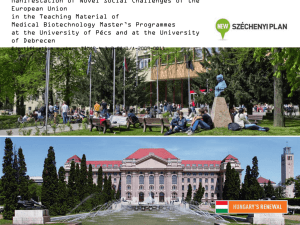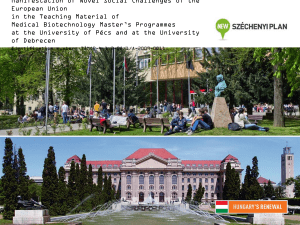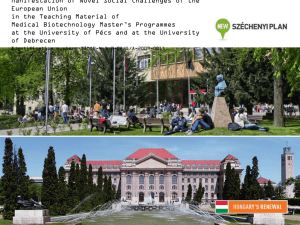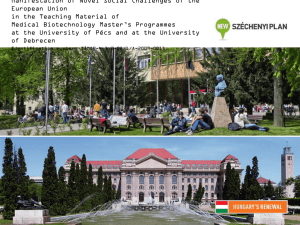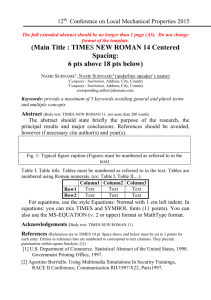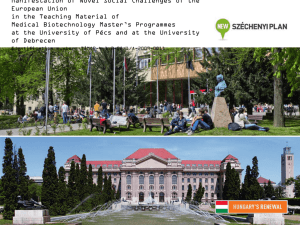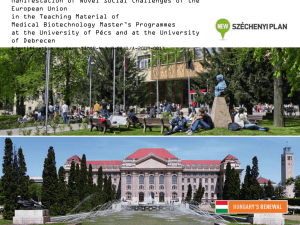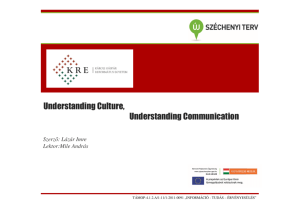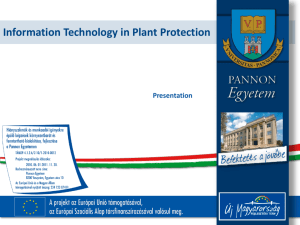„ÚTON a tudomány felé – tehetséggondozás az iskolapadtól a
advertisement
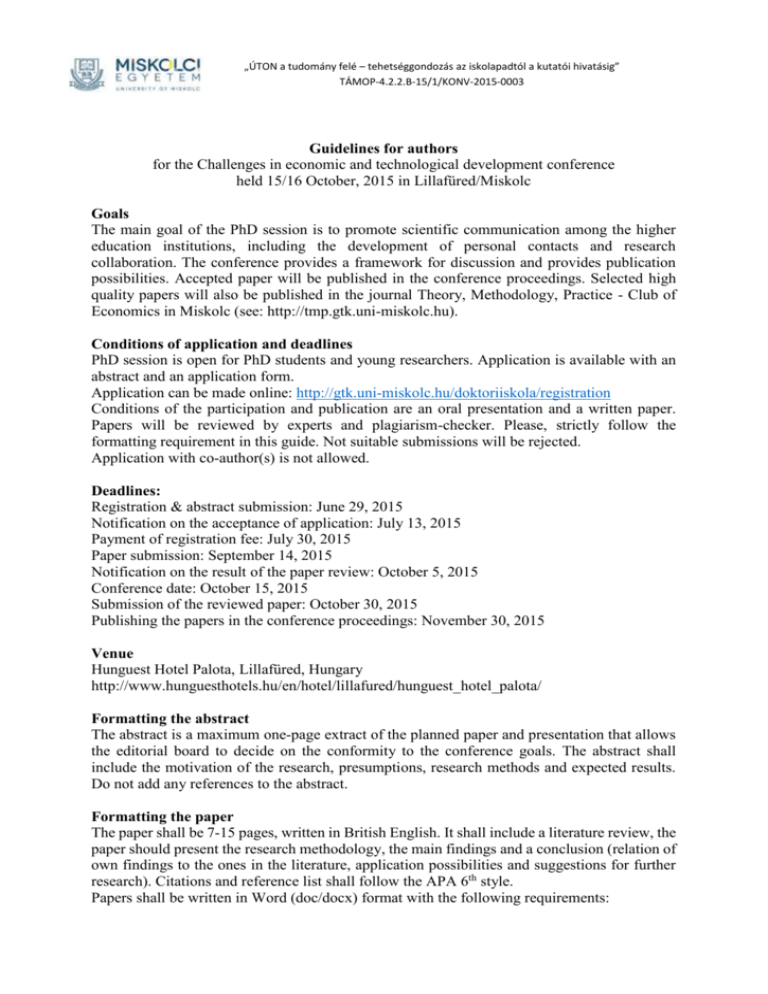
„ÚTON a tudomány felé – tehetséggondozás az iskolapadtól a kutatói hivatásig” TÁMOP-4.2.2.B-15/1/KONV-2015-0003 Guidelines for authors for the Challenges in economic and technological development conference held 15/16 October, 2015 in Lillafüred/Miskolc Goals The main goal of the PhD session is to promote scientific communication among the higher education institutions, including the development of personal contacts and research collaboration. The conference provides a framework for discussion and provides publication possibilities. Accepted paper will be published in the conference proceedings. Selected high quality papers will also be published in the journal Theory, Methodology, Practice - Club of Economics in Miskolc (see: http://tmp.gtk.uni-miskolc.hu). Conditions of application and deadlines PhD session is open for PhD students and young researchers. Application is available with an abstract and an application form. Application can be made online: http://gtk.uni-miskolc.hu/doktoriiskola/registration Conditions of the participation and publication are an oral presentation and a written paper. Papers will be reviewed by experts and plagiarism-checker. Please, strictly follow the formatting requirement in this guide. Not suitable submissions will be rejected. Application with co-author(s) is not allowed. Deadlines: Registration & abstract submission: June 29, 2015 Notification on the acceptance of application: July 13, 2015 Payment of registration fee: July 30, 2015 Paper submission: September 14, 2015 Notification on the result of the paper review: October 5, 2015 Conference date: October 15, 2015 Submission of the reviewed paper: October 30, 2015 Publishing the papers in the conference proceedings: November 30, 2015 Venue Hunguest Hotel Palota, Lillafüred, Hungary http://www.hunguesthotels.hu/en/hotel/lillafured/hunguest_hotel_palota/ Formatting the abstract The abstract is a maximum one-page extract of the planned paper and presentation that allows the editorial board to decide on the conformity to the conference goals. The abstract shall include the motivation of the research, presumptions, research methods and expected results. Do not add any references to the abstract. Formatting the paper The paper shall be 7-15 pages, written in British English. It shall include a literature review, the paper should present the research methodology, the main findings and a conclusion (relation of own findings to the ones in the literature, application possibilities and suggestions for further research). Citations and reference list shall follow the APA 6th style. Papers shall be written in Word (doc/docx) format with the following requirements: „ÚTON a tudomány felé – tehetséggondozás az iskolapadtól a kutatói hivatásig” TÁMOP-4.2.2.B-15/1/KONV-2015-0003 - Times New Roman, 12 pt font Line spacing: single (1.0) Margins: 2.5 cm (each) Text alignment is justified Alignment of title and the author’s name on the top is centered No additional feedings or indents are allowed in the paper No headings, ‘normal’ style for the entire paper Bullets and Numbering with the default settings Chapters, sub-chapters and the list of references shall be numbered (automatic numbering can be used) Figures and tables shall be numbered and also referred in the text! Alignment of figures and tables is centered. A sample format is attached to the end of the guidelines. Please, read it carefully, further guidelines in the text of the sample! The file name of the paper shall be: Paper_Name of applicant_Title of paper.doc(x). Preparing the oral presentation The time limit of the oral presentations is 15 minutes + 5 minutes discussion. Scheduling and sequence of the presentations will be in the conference program. Projector (VGA) and computer (Windows) is available in the session. Ppt/pptx presentation is preferred, in case of using other presentation formats (e.g prezi.com) the proper preparation of off-line use is highly recommended! Contact Anna Vízkeleti, vizkeletianna@gmail.com „ÚTON a tudomány felé – tehetséggondozás az iskolapadtól a kutatói hivatásig” TÁMOP-4.2.2.B-15/1/KONV-2015-0003 Sample format of the abstract Tile of the planned paper Surname, First name The abstract is important, because it will be reviewed by the editorial board before making a decision, whether the topic is suitable for the conference or not. The requirement above describes the expected content. Of course, the abstract can be customized based on the research topic and the progress of the research topic. Please, do not use blank lines between each paragraph of the abstract. Nevertheless, in case of a new content element a blank line is useful. The abstract does not allow figures, tables and citations. „ÚTON a tudomány felé – tehetséggondozás az iskolapadtól a kutatói hivatásig” TÁMOP-4.2.2.B-15/1/KONV-2015-0003 Sample format of the paper Tile of the paper Surname, First name Introduction The introduction gives a short summary about the content of the paper, including the goals, the used methods and the structure of the paper. There is a maximum 4,000 character limit of the introduction. 1. Chapter title 1.1 Sub-chapter title The structure of the paper must be prepared in harmony with the topic and the level of results. 3-5 chapters are recommended (considering the page limit of the paper). Please, do not put each paragraph into a new chapter-or subchapter. … 1.2 Listing Before and after the titles use blank lines. As you see, titles are highlighted by using bold font. In text italic font is allowed (but not necessary) for highlighting keywords. Using bullets or numbered lists is useful. Papers will be edited later, using the default settings of the Word may prevent misunderstanding: - first element, - second element, - … - last element. In case of a numbered list: 1. first element, 2. second element, 3. … 4. last element. 1.3 Citation Consider, that footnotes and end notes are not allowed. Each citation shall be included, formatting like: - …weakly correlated with performance (Khurana, 2009), - “… in case of literal citation” (Kiss, 2010:25), - Klein (2004) points out…, - is becoming increasingly important (Vink et al., 1998), - ensuring customer satisfaction (Aft, 1998; Tenner & DeToro, 1992). Cited works shall be in the list of references, and list of references shall only include cited works! 1.4 Figures and tables „ÚTON a tudomány felé – tehetséggondozás az iskolapadtól a kutatói hivatásig” TÁMOP-4.2.2.B-15/1/KONV-2015-0003 Figures (Figure 1.) and tables (Table 1.) shall be integrative parts of the paper, with reference in the text as in this sentence. Title and source is to sign as the samples show below. Source of own figures and tables can be “own work”. The titles go below figures and above tables. Figure 1. Bad sitting postures source: own work Table 1. Features of body parts loaded during office work source: Wilson (2006:103) Body part Symptom Reason Bend, blunt back pain, Not appropriate height of the Vertebral torpidness, radiant pain in limbs desk or chair. Bad positioning of keyboard and mouse. Bad body posture. Neck pain, which may radiate The monitor is set in a wrong Neck back to neck and shoulder. The angle. Not appropriate height of hard muscle tone can lead to the chair and table. Bad body narrowing of the movement. . posture and sitting posture. Head ache and tiredness can be experienced. Conclusions The conclusion summarizes the main findings of the research and the limitations. It also give an outlook for the further challenges. References 1. Becker, Gy., & Kaucsek, Gy. (1998). Termékergonómia és termékpszichológia (Product Ergonomics and Product Psychology). Budapest: Tölgyfa Kiadó. 2. Chim, J. (2013). The FITS model office ergonomics program: A model for best practice. Work: A Journal of Prevention, Assessment and Rehabilitation 48(4), 495-501. 3. Wilson, J. (1986). The ergonomics of working postures. London: Taylor & Francis. „ÚTON a tudomány felé – tehetséggondozás az iskolapadtól a kutatói hivatásig” TÁMOP-4.2.2.B-15/1/KONV-2015-0003 (Formatting the list of references the APA 6th style is expected. See e.g.: http://sydney.edu.au/library/subjects/downloads/citation/APA%20Complete_2012.pdf) Contact information: Name University, faculty Mailing address of the research institute E-mail
